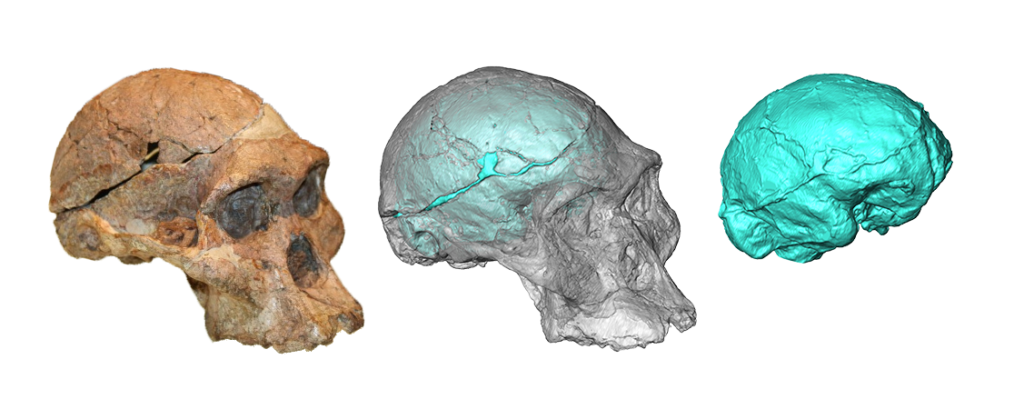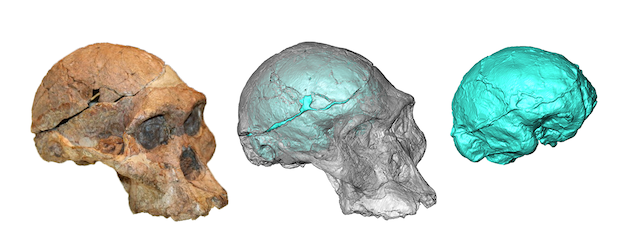As highlighted by the comparative anatomy of extant primate taxa, the human brain is highly specific in terms of volume, global shape, local organization and connectivity. Because brain tissue is not preserved in the fossil record, studies in paleoneurology focus on brain endocasts (i.e., replica of the inner table of the bony braincase). From hominin fossil endocasts, paleoneurologists may access information related to the global and local morphology of the brain and the organization of cortical and functional areas. In this context, I am developing two main research projects with the aim of characterizing the brain morphology in early hominin species for identifying potential human-like features, and of discussing the cerebral organization in extinct hominin taxa with potential functional implications related to crucial innovations in human evolution, such as language or toolmaking.

Results
- Our study of the enodocast of KNM-ER 3732 (Kenya) reflects a high degree of diversity with in the cerebral organisation of the earliest humans (link).
- When did the shape of our brain emerge? Our study of the endocast of Border Cave 1 (Afrique du Sud) tells us more about this fundamental question (link).
- The issue of the nature of the phylogenetic relationships between the Paranthropus species as well as their behaviour and biology have been the centre of intense debates since the first discoveries. We analyzed the endocasts of two key specimens from South and East Africa and provided new insights into the identity of this enigmatic hominin group (link).
- The nearly complete skull of “Little Foot” has a lot to say about the evolution of the brain in early hominins. We described for the first time the endocast of “Little Foot” and revealed exciting details about the neuroanatomy of Australopithecus (link).
- We published a quantitative analysis of the endocast of two key-specimens in paleoneurology, “Mrs Ples” and Sts 60 from the Sterkfontein Formation. Because of their preservation state, these two Australopithecus africanus specimens are critical for understanding early hominin brain changes (link).
- Are endocasts reliable proxies for brain? Here is the answer!
- Because of the role of the prefrontal cortex in executive functions and language, the frontal lobes are of major interest in paleoneurology. We investigated the frontal morphology of three relevant East African fossil humans from early and middle Pleistocene: OH 9, UA 31 and Bodo (link).
- We are developing an atlas documenting the variation in the sulcal pattern of extant human endocasts for subsequent use as a comparative platform for the study of the fossil record. As preliminary results, we could identify sulci that could be nearly systematically detected and identified on human endocasts (link).
- We presented our work on primate brain evolution and our analytical approach for the study of the virtual endocasts in a book dedicated to digital endocasts (link).
Syntheses
- The discovery of the “Taung child” and, more broadly, South African research in paleontology, has significantly contributed to our understanding of human brain evolution. We published a review synthesizing 100 years of research in human paleoneurology as part of a special issue commemorating the centenary of the “Taung child” discovery (link).
- In 2023, we organised a conference in Johannesburg (South Africa) and invited experts in neuroscience, paleontology and artificial intelligence to discuss new tools to be developped for studying fossil brains. We summarized the outcomes in a special issue (link).
- In 2021, we organised an online workshop on studying brains and behaviours in fossil groups and published a synthesis (link) as well as a volume (link).
- What do we know about the brain of the earliest humans? Here is a summary published in Science.
- What can fossils tell us about the emergence of language in the hominin lineage? I discussed this fascinating aspect of paleoneurology in a paper that concludes by insisting on the relevance of a multidisciplinary approach (link).
